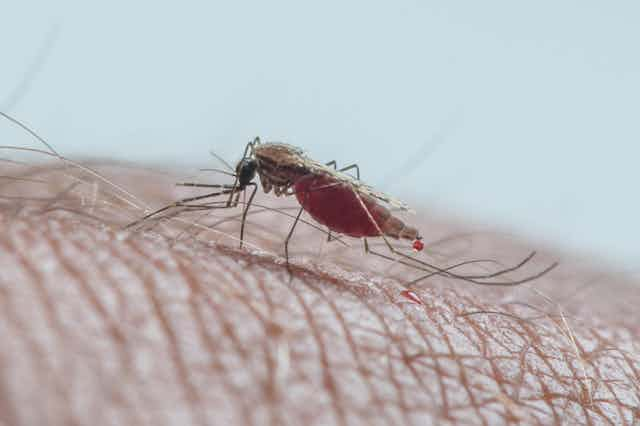Malaria is a risk to three quarters of the population in the Southern African Development Community, a 16-member organisation that draws in countries across southern and eastern Africa.
Some countries in the region have set a target to eliminate the disease from as early as 2023 to 2030.
Though this won’t be simple, it can be done. It’s a race between changes in mosquitoes, the malaria parasite, and changes in what people can do when they work together.
This complex disease is still responsible for almost half a million deaths annually worldwide, including more than 260,000 African children under five. The World Health Organization (WHO) estimates that 35 million children under five and about 8.5 million pregnant women in the region are at risk.
The Southern African Development Community (SADC) renewed its malaria control efforts in 2009 by establishing the Elimination 8 initiative. This is a coalition of eight countries working together to curb the spread of the disease. Four of them – eSwatini, Botswana, Namibia and South Africa – are reporting very low transmission. The other four – Angola, Mozambique, Zambia and Zimbabwe – are high-burden countries.
Current control strategies mostly target the mosquito vector, which transmits the malaria-causing parasites to humans when feeding. Vector controls include indoor residual spraying and insecticide-treated bed nets. Resistance to insecticides and changes in mosquito biting behaviour are slowing down gains made in malaria control over the past decade.
In the Southern African Development Community region, malaria transmission dynamics remain highly interconnected. This is because countries share related populations, economies, ecologies and epidemiologies.
This interconnectedness is leading to the identification of new gaps and challenges. But it is also allowing innovative alternative and complementary strategies to be developed through research across disciplines – and through collaboration.
Our experience over the past 10 years includes collaborations across the sciences and social sciences. Our work addresses anything from vector and parasite control to capacity building and education. It’s testament that an integrated approach is needed to reach elimination.
Latest breakthrough
The most recent advance in the fight against malaria is the first ever vaccine (RTS,S/AS01). The WHO announced in October 2021 that it had approved the vaccine for use in children living in moderate to high malaria transmission areas.
The vaccine brings hope to affected communities. It is a step toward malaria elimination.
Read more: Malaria vaccine is a major leap forward: but innovation mustn't stop here
But it’s not a cure. And it has limitations:
it is only effective in very young children (five to 17 months)
at least four doses (including a booster 18 months after the initial dose) are needed for optimal effect
it prevents severe disease but not necessarily infection
it is only effective against Plasmodium falciparum – one of five human malaria parasites.
In spite of these limitations, the vaccine can contribute to making gains in malaria control again. The danger is that the vaccine announcement may lead to countries taking their eyes off the ball. This can’t happen.
Even with a vaccine in hand, there are some big gaps that need to be filled for the region, and the globe, to reach malaria elimination.
Some of the gaps
One such a gap is in human resources. In particular, leadership and management skills in national malaria control programmes. Adequate training is needed to address these capacity challenges. The Southern African Development Community region has not benefited from routine training offered to national malaria control programmes in west and east Africa.
To address this, the Gates Foundation is providing financial backing for a course to be developed and delivered by a transdisciplinary team. The course aims to provide people with the skills they need as leaders, managers, implementation scientists and facilitators that can develop and apply effective evidence-based elimination strategies. This is an exciting new collaboration that will involve the University of Pretoria’s Gordon Institute of Business Science (GIBS) and the Albert Luthuli Leadership Institute.
The course will also aim to get women into more senior positions on national malaria control programmes.
A second worrying gap relates to fighting growing resistance to antimalarial drugs. Malaria treatment is dependent on drugs that either prevent disease onset or treat infected patients and prevent death. But there’s evidence of increasing parasite resistance to antimalarial drugs.
Continuous discovery and development of innovative antimalarial drugs that target all forms of the parasite are needed. We are doing ground-breaking work in this area. For example, a consortium approach has made a breakthrough discovery and has led to exciting developments in the areas of parasite transmission blocking, where two potent chemical compounds showed activity against all parasite forms in a laboratory setting. Both compounds show potential as drug candidates for malaria treatment and transmission blocking.
Future antimalarial drugs like this will ultimately mean that the region can move from malaria control to elimination.
In addition, more sustainable vector control methods need to be developed to overcome insecticide resistance.
Our work across disciplines has shown how collaboration can produce tools and strategies to address this. For example, ongoing research have looked at innovative product development, including polyethylene wall linings, and new repellent formulations.
There are also still gaps on the ground in how control strategies are rolled out. Many don’t have enough community buy-in. This is key to success. Communities must be aware of malaria research taking place to understand its purpose and benefits. And people need knowledge about the disease so they have the power to take responsibility for their own health.
A major – and important – gap is funding. The malaria budget must increase substantially to incorporate the human resources, technology and other resources needed to effectively reduce transmission and to reach elimination.

